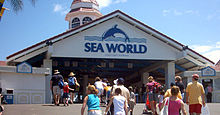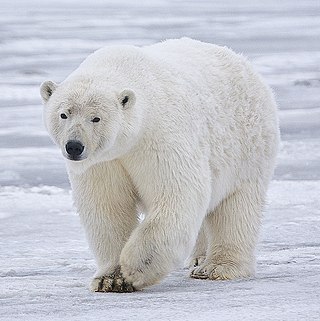
The polar bear is a large bear native to the Arctic and surrounding areas. It is closely related to the brown bear, and the two species can interbreed. The polar bear is the largest extant species of bear, with adult males weighing 300–800 kg (700–1,800 lb). The species is sexually dimorphic, as adult females are much smaller. The polar bear is white- or yellowish-furred with black skin and a thick layer of fat. It is more slenderly built than the brown bear, with a narrower skull, longer neck and lower shoulder hump. Its teeth are sharper and more adapted to cutting meat. The paws are large and allow the bear to walk on ice and paddle in the water.
The Saint Louis Zoo, officially known as the Saint Louis Zoological Park, is a zoo in Forest Park, St. Louis, Missouri. It is recognized as a leading zoo in animal management, research, conservation, and education. The zoo is accredited by the Association of Zoos and Aquariums (AZA). Admission is free based on a public subsidy from a cultural tax district, the Metropolitan Zoological Park and Museum District (ZMD); fees are charged for some special attractions. A special feature is the 2 ft narrow-gauge Emerson Zooline Railroad with passenger trains pulled by Chance Rides C.P. Huntington locomotives that encircle the zoo, stopping at the more popular attractions.

The San Diego Zoo is a zoo in Balboa Park, San Diego, California, housing 4,000 animals of more than 650 species and subspecies on 100 acres (40 ha) of Balboa Park leased from the City of San Diego. Its parent organization, San Diego Zoo Wildlife Alliance, is a private nonprofit conservation organization, and has one of the largest zoological membership associations in the world, with more than 250,000 member households and 130,000 child memberships, representing more than a half million people.

Sea World is a marine mammal park, oceanarium, and theme park located on the Gold Coast, Queensland, Australia. It offers attractions such as rides and animal exhibits and promotes conservation through education and the rescue and rehabilitation of sick, injured or orphaned wildlife. The park is commercially linked to Warner Bros. Movie World and Wet'n'Wild Gold Coast as part of the theme park division of Village Roadshow. The park has no affiliation with an American park chain of a similar name.

The Columbus Zoo and Aquarium is a non-profit zoo located near Powell in Liberty Township, Delaware County, Ohio, United States, north of the city of Columbus. The land lies along the eastern banks of the O'Shaughnessy Reservoir on the Scioto River, at the intersection of Riverside Drive and Powell Road. It has a worldwide reputation, largely attributable to the efforts and promotion of director emeritus Jack Hanna. In 2009, it was named by the USA Travel Guide as the number one zoo in the United States. It was also ranked number one best zoo in 2012 by Besties Readers Choice.
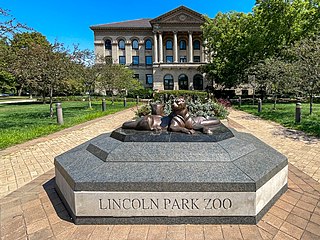
Lincoln Park Zoo, also known as Lincoln Park Zoological Gardens, is a 35-acre (14 ha) zoo in Lincoln Park, Chicago, Illinois. The zoo was founded in 1868, making it the fourth oldest zoo in North America. It is also one of a few free admission zoos in all of North America. The zoo is an accredited member of the Association of Zoos and Aquariums (AZA). The zoo also became an accredited arboretum in 2019.

The Detroit Zoo is a zoo located in the cities of Huntington Woods and Royal Oak in the U.S. state of Michigan. Spanning 125 acres (50.6 ha), it houses more than 2,000 animals and more than 245 different species. It was the first U.S. zoo to feature bar-less habitats, and is regarded to be an international leader in animal welfare, conservation and sustainability by the Detroit Zoological Society.

Misha, also known as Mishka or The Olympic Mishka, is the name of the Russian Bear mascot of the 1980 Moscow Olympic Games. He was designed by children's books illustrator Victor Chizhikov.

The Berlin Zoological Garden is the oldest surviving and best-known zoo in Germany. Opened in 1844, it covers 35 hectares and is located in Berlin's Tiergarten. With about 1,380 different species and over 20,200 animals, the zoo presents one of the most comprehensive collections of species in the world.
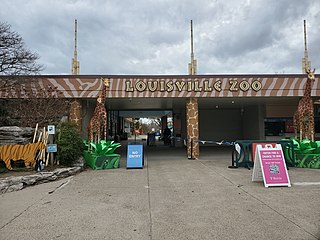
The Louisville Zoological Gardens, commonly known as the Louisville Zoo, is a 134-acre (54 ha) zoo in Louisville, Kentucky, situated in the city's Poplar Level neighborhood. Founded in 1969, the "State Zoo of Kentucky" currently exhibits over 1,200 animals in naturalistic and mixed animal settings representing both geographical areas and Biomes or habitats.

Warner Bros. Movie World is a theme park on the Gold Coast in Queensland, Australia. Owned and operated by Village Roadshow Theme Parks, the park opened on 3 June 1991. It is part of a 154-hectare (380.5-acre) entertainment precinct, with the adjacent Village Roadshow Studios and nearby Wet'n'Wild Gold Coast, among other sites operated by Village Roadshow. Movie World is Australia's only film-related theme park and the oldest of the Warner Bros. parks worldwide. As of 2016, it receives a yearly average of 1.4 million visitors.

Auckland Zoo is a 16.35-hectare (40-acre) zoological garden in Auckland, New Zealand, situated next to Western Springs Park not far from Auckland's central business district. It is run by the Auckland Council with the Zoological Society of Auckland as a supporting organisation.

Denver Zoo is an 80-acre (32 ha) nonprofit zoological garden located in City Park of Denver, Colorado, United States. Founded in 1896, it is operated by the Denver Zoological Foundation and funded in part by the Scientific and Cultural Facilities District (SCFD) in addition to ticket sales and private donations. It is the most visited paid attraction in Colorado.
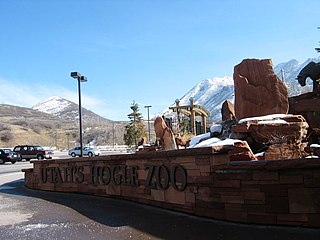
Utah's Hogle Zoo is a 42-acre (17 ha) zoo located in Salt Lake City, Utah. It houses animals from diverse ecosystems. It is located at the mouth of Emigration Canyon. Hogle is an accredited member of the Association of Zoos and Aquariums (AZA) and the World Association of Zoos and Aquariums (WAZA).
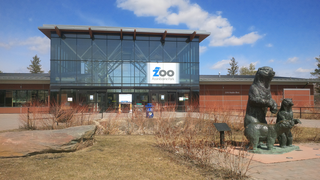
Assiniboine Park Zoo is an 80-acre (32 ha) zoo at the west end of Assiniboine Park in Winnipeg, Manitoba, Canada. It has been best known for decades for its polar bear exhibit, of which the old enclosure was replaced in 2013 with Journey to Churchill.

Shambala Animal Kingdom was a 53 hectares zoological park outside Kuranda, Queensland, Australia. The park was privately owned. It was formerly known as "Cairns Wildlife Safari Reserve", "Mareeba Wild Animal Park" and "Out of Africa Reserve". After being purchased by a Sydney lawyer, the zoo was renamed "Shambala Animal Kingdom". The zoo was closed in April 2013 citing financial reasons.

Flocke is a female polar bear who was born in captivity at the Nuremberg Zoo in Nuremberg, Germany on 11 December 2007. A few weeks after her birth, she was removed from her mother's care after concerns were raised for her safety. Although the zoo had established a strict non-interference policy with its animals, officials chose to raise the cub by hand. This decision came at a time when the zoo was receiving negative attention from the media after another female polar bear reportedly ate her newly born cubs.

Knut was an orphaned polar bear born in captivity at the Berlin Zoological Garden. Rejected by his mother at birth, he was raised by zookeepers. He was the first polar bear cub to survive past infancy at the Berlin Zoo in more than 30 years. At one time the subject of international controversy, he became a tourist attraction and commercial success. After the German tabloid newspaper Bild ran a quote from an animal rights activist that decried keeping the cub in captivity, fans worldwide rallied in support of his being hand-raised by humans. Children protested outside the zoo, and e-mails and letters expressing sympathy for the cub's life were sent from around the world.

The Yorkshire Wildlife Park is a wildlife conservation and rehabilition centre and tourist attraction located in Branton, south-east of Doncaster, South Yorkshire, England. It opened in 2009 on the site of Brockholes Farm, a former riding school and petting zoo, and features 500 animals of 100 species. Yorkshire Wildlife Park is an official member of the British and Irish Association of Zoos and Aquariums (BIAZA) and the European Association of Zoos and Aquaria (EAZA).

Seal Harbour is a seal and sea lion exhibit at the Sea World theme park on the Gold Coast, Australia. It officially opened to the public in January 2013.





















